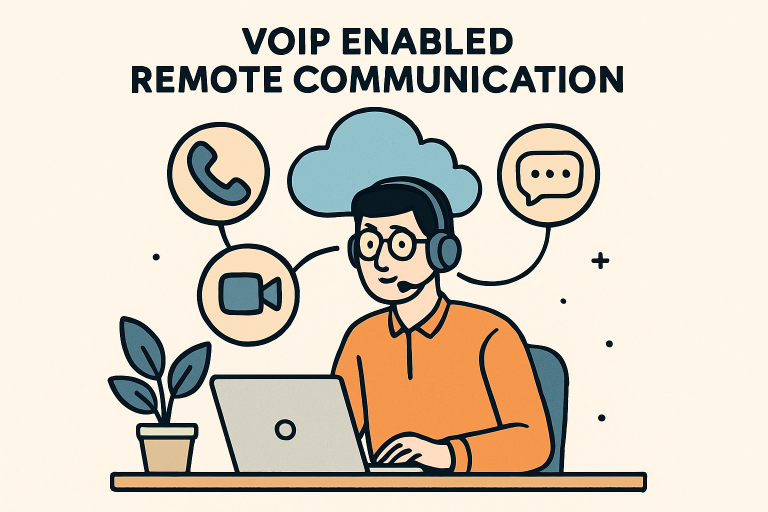
Why VoIP Remains Essential for Remote Teams
Expanding remote and hybrid work has revolutionized how organizations approach collaboration and communication. Voice Over IP (VoIP) has emerged as a foundational technology, enabling remote teams to remain highly accessible, responsive, and cohesive regardless of geographic distance. By leveraging internet-based calling, teams can maintain seamless communication channels, keeping projects moving and client relationships strong.
Traditional phone systems often limit business agility and cost savings. In contrast, VoIP solutions provide advanced flexibility for businesses of all sizes, including those seeking a robust small business phone solution. This adaptability ensures organizations can scale their communication systems affordably, access powerful features, and maintain continuity even as workforces become increasingly distributed.
Cloud solutions are inherently mobile. Staff can handle calls, messages, voicemails, and even video conferences in a home office, coworking space, or on the go. This agility makes it easier for organizations to attract and retain top talent, regardless of their physical location.
Seamless Integration with Critical Workplace Tools
A modern VoIP system functions far beyond basic calling. It integrates smoothly with critical productivity tools like email, CRMs, project management suites, and helpdesk systems. These integrations are pivotal for remote teams, automatically linking communications with customer records, help requests, and tasks.
For example, during client calls, sales teams can view critical customer information automatically on their screens, while support agents document and track call outcomes in real time through their helpdesk platform. Such automated workflows minimize manual data entry, prevent errors, and boost the overall efficiency of remote teams.
UCaaS: Connecting Voice, Video, and Chat
The rise of Unified Communications as a Service (UCaaS) is streamlining remote collaboration. UCaaS platforms combine VoIP, video conferencing, instant messaging, file sharing, and team collaboration tools under a single cloud-based interface. This convergence improves user experience by reducing software fatigue and simplifying IT support for distributed teams.
With unified solutions, colleagues can easily transition from a chat conversation to a voice call or video meeting, seamlessly sharing files and ideas. For businesses with remote or global teams, UCaaS creates a centralized hub for all communication, ensuring everyone stays aligned and focused on their core projects.
Addressing Security and Privacy Challenges
Ensuring security and privacy in VoIP deployments is non-negotiable. Voice data traversing the Internet is susceptible to interception and cyber threats. The most effective VoIP setups employ end-to-end encryption, multifactor authentication, and vigilant network monitoring to keep communications confidential.
Regular staff training on cybersecurity best practices—such as identifying phishing attempts and implementing strong passwords—is critical. Ongoing updates and proactive patch management further reduce vulnerabilities. As remote work expands, so do the threats to digital communication, underscoring the need for a continuously evolving security plan.
Choosing the Right VoIP Solution
1. Assess your team’s size, remote work needs, and anticipated growth.
2. Determine the importance of supporting features like mobile apps, video meetings, call analytics, and CRM or helpdesk integrations.
3. Research your shortlist of vendors: check independent reviews, analyze uptime guarantees, and evaluate customer support responsiveness.
4. Take advantage of free trials or pilot programs to test the platform’s call quality and user experience in real-world scenarios before committing.
Selecting the right VoIP solution from the outset avoids costly future migrations and unlocks the full range of productivity and cost-saving benefits that modern communication platforms provide.
Future Trends in VoIP and Remote Work
The workplace of the future is digital-first, and VoIP is at the heart of this evolution. Artificial intelligence is making its way into communications, automating call routing, real-time transcription, and even language translation to create more inclusive team environments. As 5G technology rolls out globally, expect mobile VoIP performance to reach unprecedented reliability, transforming how calls are placed and received on the move.
Looking ahead, businesses are beginning to experiment with immersive technologies for collaboration. Tools such as augmented and virtual reality meetings promise further to bridge the gap between in-person and remote communication, helping distributed teams innovate and connect more meaningfully. With organizations no longer restricted by geography, the possibilities for connected, collaborative work are expanding at a rapid pace.